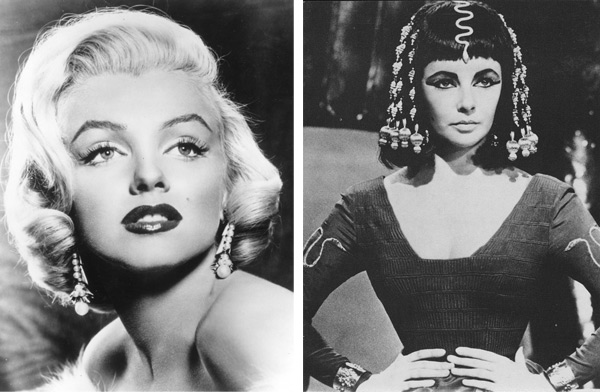
The location of the largest stash of Golden Age Hollywood jewelry in the world worn by stars like Marilyn Monroe, Elizabeth Taylor, Grace Kelly, and Greta Garbo, thousands of gems have apparently been gathering dust in an unmarked warehouse, unmolested for half a century. It sounds too good to be true.
First Impressions
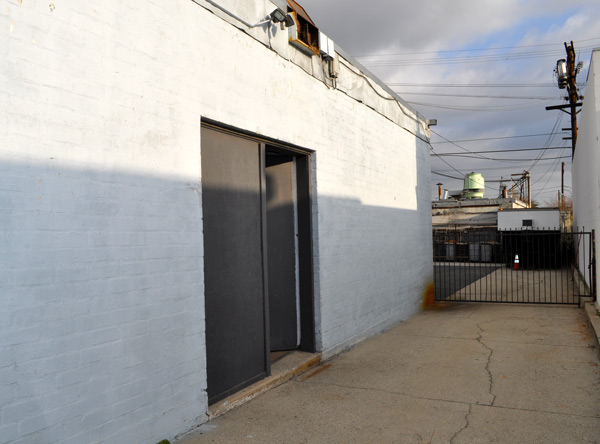
This entrance does no justice to the treasures within
The treasure is purportedly in the longtime studio of Joseff of Hollywood, jewelry maker to the biggest Golden Era movie stars. From the outside, it looks like any other drab warehouse with a weathered door and spy the metal lettering with the signature “Joseff” logo. There is no doorbell.
The humble gray entry only hints at the treasures inside: Movie stills hang in frames as though nothing has changed since 1940.
The studio, a tiny space, maybe 100 square feet, is entirely painted a startling turquoise blue. A crowned Buddhist-inspired god of jewels welcomes entrants from the back-wall mural, where he is portrayed dusting the sky with stars (real Swarovski crystals). Another wall is lined with bright blue drawers, topped with golden and bejeweled crowns, tiaras, scepters, and armor, some of which peep out of pirate’s chests. A truly magical space.

Michele (left) and Tina Joseff (relatives of creator) in front of trays housing thousands of famous jewelry pieces.
It is surprising that the studio is so small; jewelry does not require much space.
Thousands of pieces of Hollywood history are crammed into drawers and trays. Open one blue drawer and you might find snakes; another could be bejeweled daggers. The opposite wall is stacked floor to ceiling with black velvet-lined trays. This is where the most coveted pieces have been carefully catalogued, ordered first by type and then gem color.

The “most spectular necklace in the world,” a giant bib worn by Ona Munson in “Shanghai Gesture.”
All the pieces of history. A breathtaking “topaz” bib necklace first worn by Ona Munson in 1941’s “Shangai Gesture,” dubbed “the most spectacular necklace in the world,” this “wow” piece has appeared in more movies than any piece in the whole collection. It is hard to take one's eyes off it.
The Crown Jewels

The crown jewels of Hollywood, including the snake bracelets worn by Rita Hayworth in 1947′s “Down to Earth,” the leaf brooch worn by Jean Harlow in 1936′s “Libeled Lady,” and the bird bracelets worn in 1944′s “Desert Hawk.” Click on the image to take a closer look.
The most famous pieces are kept in a circular glass display case in the corner. Elizabeth Taylor’s serpent belt from “Cleopatra,” Marilyn Monroe’s pearl earrings from “Gentlemen Prefer Blondes,” Scarlet O’Hara’s necklace, and Rhett Butler’s cigar case. Not to mention Jean Harlow’s glamorous “Libeled Lady” brooch, Judy Garland’s “Ziegfeld Follies” lariat necklace, and the exotic bird bracelets from “Desert Hawk.”
The reason these pieces are together is a testament to Joseff’s business savvy. Instead of letting the studios keep the best pieces, he held on to them and rented them over and over through the decades. Moreover, since it is “only” costume jewelry, it was not regarded as particularly valuable until very recently.

Open one of the turquoise blue drawers at the Joseff studio, and you might find bejeweled daggers.
While contemplating the snake bracelets worn by Rita Hayworth when she played a goddess in 1947’s “Down to Earth,” which were definitely made for tiny wrists, and the snake belt famously worn by Liz Taylor in 1963’s “Cleopatra.” Tina explains that Joseff and his wife and business partner, Joan Castle Joseff, worked mostly with the costume designers but at times, they got to fit the stars directly, as was the case with this belt.
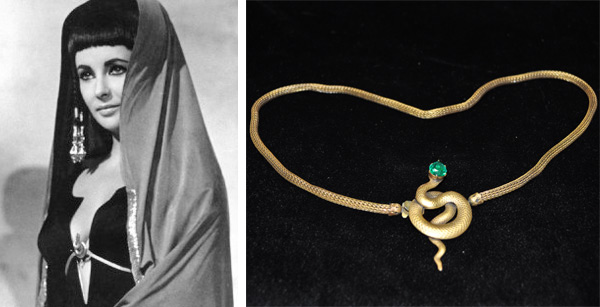
Elizabeth Taylor insisted that this Joseff of Hollwood snake belt, which she wore in 1963′s “Cleopatra,” had been measured wrong. It now lives in the glass display with other Joseff treasures.
“Joan had gone out to the studios and measured Liz Taylor for a belt for one of the costumes,” Tina recalls. “By the time the belt was created and she took it back for the fitting, it was about 2 1/2 inches too small. Liz Taylor was known for her fluctuating weight back then. But she blamed it on Joan and said that Joan had not measured her correctly. Of course, Joan didn’t argue with her, but she told me, ‘I know I measured right.’ The rule is measure twice, cut once, and Joan was very thorough.
“Those are things that happen in Hollywood,” Tina continues. “She would go with the flow and do whatever was needed to make it work. That was the way both of them were.”
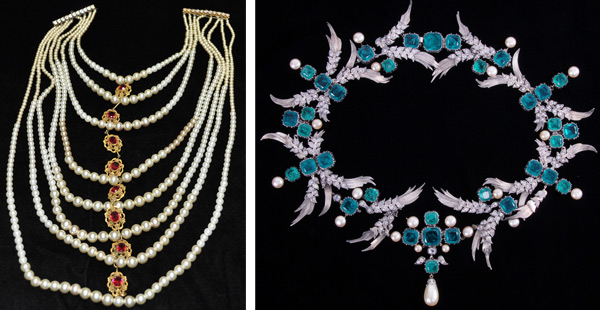
At left, the giant nine-strand faux pearl necklace worn by Bette Davis in 1939′s “The Private Lives of Elizabeth and Essex.” At right, the choker Greta Garbo refused to wear for 1936′s “Camille.”
Back to the black velvet trays, Tina and Michele lift out a tremendous necklace, worn by Bette Davis in 1939’s “The Private Lives of Elizabeth and Essex” and the manly Tyrone Power in 1939’s “The Rains Came.” It has nine long strands of faux-pearls, connected down the middle by crystals set in Joseff’s trademark golden-plated filigree. So spectacular and with a backless gown isdefinitely red-carpet worthy. If today’s stars knew about Joseff of Hollywood, would they dare wear it in the spotlight?
The Joseffs take out the elaborate “emerald” and “diamond” necklace that Greta Garbo refused to wear in 1936’s “Camille.” It appears to be a tight-fitting choker, with uncomfortably pointy sterling silver leaves. “In the scene where she was going to wear the necklace, she was required to have a cape over it,” Tina says. “The necklace cut her from the weight of the cape, so she wouldn’t wear it. The scenes filmed with the necklace ended up on the cutting room floor.”
The single pearl drop Errol Flynn wore in “The Adventures of Don Juan” was not seen. Top costume jewelry expert and antique book publisher Judith Miller related a particularly amusing story Joan Castle Joseff relayed to her about Flynn, who was rumored to be gay, and this particular earring.

Katharine Hepburn wore this Joseff dual brooch, meant to look like an arrow going through her heart-shaped dress, in 1947′s “Sea of Grass.” The set is one of Tina Joseff’s favorites in the collection.
“Joan told me, ‘No, he really did love the gals, especially between takes,’” Miller said. “They ended up making him 22 of those earrings. Apparently, he lost 21 with the ladies in his dressing room.”
Joseff didn’t mind the hard work. Some movies required hundreds of pieces, Tina explains. “In ‘Anna and the King of Siam,’ the king had multiple wives and 67 children, and they all had to have jewelry,” she says. In fact, 1942’s live-action “The Jungle Book” demanded Joseff provide thousands of pieces.

A thief’s armor for 1942′s “The Jungle Book.”
From the top of the ledge of drawers, Tina and Michele take down a large, red breastplate from “The Jungle Book,” with swirling bejeweled strips of golden metal and golden faces, and put it on the mannequin, from one of the sets of armor made for the three thieves in the movie. Tina says that several times a day during the filming, an employee from Joseff would replace the rhinestones that had fallen off the armor due to all the jumping and wrestling of the actors.
“For ‘The Jungle Book,’ there were metal vests, large cuffs, and big, heavy belts with a lot of chains that were created specifically for that movie,” she says. “But then, for the treasure trove the thieves discover in the cave, it was full of scrap or broken jewelry pieces and regular coins that were plated to look bright and shiny.”
Michele explains that the jewelry in the trays were not all made by Joseff. Some of it is Trifari. “When he couldn’t make it or even when he just was out somewhere, he bought jewelry just to have it in the rental collection,” she says. ”There were thousands of pieces that are ours. There’s probably hundreds of pieces that are by other makers.”

Eugene Joseff dons the crown and scepter worn by Ronald Colman in 1937′s “The Prisoner of Zenda.” Seventy-some years later, Decades Inc. co-owner Cameron Silver poses in the same crown.
Cameron Silver, a big player in the current Hollywood vintage scene, says he walked in having no idea about Joseff of Hollywood—which tells you something about how out of the spotlight the company has been in recent decades. As the magnificent pieces come out, one by one, he got more excited, and began to bubble with ideas to make the company’s legacy known.
Silver dons the crown and scepter worn by Ronald Coleman in 1937’s “The Prisoner of Zenda.” Amusingly enough, an old image of Eugene Joseff shows him looking regal in that crown. When he puts it on, “I’m going to call this one “Crowning Around,” Silver declares.

From left: Tina and Michele Joseff, me, and Cameron Silver.
Inspired by Silver, we decide to get a picture of all of us in crowns, “Here, do you want to wear Shirley Temple’s crown?” - the tiara and scepter the child star wore in 1939’s “The Little Princess.”
How It All Started
Crowns and scepters were probably the last things on Eugene Joseff’s mind when he started working in the advertising business in Chicago, where he also was an apprentice in an art foundry. There, he learned how to forge statuettes and decorative items out of bronze. He left in 1928 to make his future in California, specifically, Hollywood.Thanks to his “outgoing and wild personality,” Eugene Joseff quickly fell into the movie-making crowd when he landed in Hollywood in the late 1920s. “He just was the type that attracted people to him,” says Tina, who started working for the company in 1972.

Joseff and his brother Jimmy Glaser look at their wares. The huge acrylic headpiece was worn by Virginia Bruce in 1936′s “The Great Ziegfeld.”
The year after his move, the Great Stock Market Crash sent the economy into a devastating tailspin that left a large number of Americans broke and jobless. Fortunately for Joseff, Hollywood was the place to be during the ’30s and ’40s, when impoverished Americans found refuge in films. For a couple dimes, they could fantasize about wealth and glamour.
“Eugene Joseff revolutionized the way jewelry was used in movies.”Joseff’s Hollywood-insider friends, like costume designer Walter Plunkett, would take him to the movies they made or invite him to visit their movie sets. Instead of being intimidated, Joseff loudly mocked the jewelry costumers put on the actresses.
“He wasn’t shy,” Tina says. “He was criticizing the use of modern jewelry in period films. It became a challenge—what can you do to make it better?—and he did.”
Joseff accepted this challenge, and set out to make the most historically accurate costume jewelry possible. He dug into historical books and piles of bound magazines like “Ladies Field” and “Harper’s Bazar” from the Victorian Era. He traveled, visited museums, and studied pieces from the Renaissance and ancient times in detail.
“He wasn’t shy. He was going on set and criticizing that they were using modern jewelry on period films.”At his Sunset Boulevard home in Hollywood, Joseff began experimenting with processes for making costume jewelry in his garage. With his brother Jimmy Glaser, he founded Sunset Jewelry Manufacturing. After a couple years Jimmy—who was married to Hollywood costume designer Leah Rhodes—left the company, and Eugene began to look for jewelry craftsmen, while continuing to tinker on his own.
“He did a lot self-taught and through trial and error,” Tina says. “He had a creative mind, and he didn’t mind making mistakes. When he first started out, he was gathering leaves and little acorns and bugs and cabinet knobs, turning those into castings. He was doing a lot of experiments with what he could accomplish with pouring metal.”
Groundbreaking Innovations

Grace Kelly wore Joseff of Hollywood chandelier earrings in 1956′s “High Society”
According to Tina, he started perusing industry publications like “Hollywood Reporter” or “Variety” to find out what films were in the works. Then he’d call up the studios to say, “I think I can provide jewelry for this. Give me a script,” or “Give me some sketches.”
“Jewelry didn’t really appear in movies too much before he came along,” Tina says. “I think the costumers had either just gone to a department store and bought the jewelry, or in many cases, it probably belonged to the star herself and she just accessorized her own outfit.”
At first, Joseff worked with limited budgets, making pieces to order, which inspired him to start renting his jewelry to studios, a concept he pioneered.

Vivian Leigh wears Joseff in a dining scene with Clark Gable in 1939′s “Gone With the Wind.”
“When he started out, he didn’t have a collection; he only had pieces as he made them.” Tina explains. “So he thought, ‘I spent so much money making this piece; how am I going to get my money back?’ Then it occurred to him, ‘I can make it once, and rent it 10 times.’ If he had just sold it, he would’ve been out the piece, he wouldn’t have developed a collection, and everything would’ve been back to square one.”
In the ’30s and ’40s, Joseff was supplying over 90 percent of the jewelry in the movies. according to Michele. “Antiques Roadshow” appraiser Rosalie Sayyah, a costume jewelry expert who goes by the name “Rhinestone Rosie,” agrees that Joseff, who employed between 35 and 70 during his company’s peak years, made an impact on Hollywood and fashion that cannot be underestimated.

Rhett Butler’s one-of-a-kind cigar case from “Gone With the Wind” will never be rented to a movie studio again. Same goes for his belt buckle and Scarlett O’Hara’s jewelry.
“Hands down, Eugene Joseff revolutionized the way jewelry was used in movies,” Sayyah says. “He was also a marketing genius and a perfectionist. He manufactured his own jewelry because the manufacturers told him, ‘You can’t make this look as good as you want it to be,’ so he did his own thing.”
Not only did he set high standards for himself, Joseff was thrifty and resourceful, Sayyah says. “He would make a piece for one movie and then it might be disassembled and reassembled in another way for another movie,” she explains. “He was very organized, so he could either re-create something using parts he already had, or he would say, ‘Yes, I can have that for you,’ and he would build the piece from the ground up.”
Where It’s Still Made
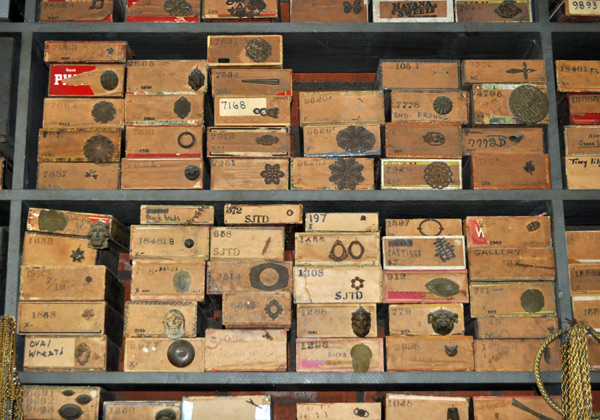
Jewelry parts are still stored in cigar boxes, as they were in Joseff’s time. The writing on the boxes has yet to be decoded, but Tina and Michele know the numbers have to do with the dealer Joseff bought his parts from and the price he paid. Click image for a larger view.
“When he first started out, he cast leaves, acorns, bugs, and cabinet knobs in metal.”The workshop where Joseff kept all of his parts and forged his famous pieces is still there, in the room behind the studio.
This room has a wall stacked floor to ceiling with old cigar boxes—the same ones used by Joseff all those years ago. Filled with large metal findings shaped like flowers, skulls, and animals like snakes or elephants, small findings are kept in a card catalog, while a rainbow of Swarovski crystals are stored in clear glass jars and chains hang from the ceilings and walls.

Joseff and actress Katherine Wilson look over his supply of chains. Joseff always kept plenty of chains on hand to meet emergency studio orders. The cigar boxes behind Wilson are the same ones used today.

A work station where jewelry has been made for Hollywood’s biggest stars. Click image for a larger view.
The manufacturing plant, where Joseff’s trademark metal jewelry findings are cast began as World War II was brewing in 1939, Joseff also turned his metalworking talents toward developing techniques for manufacturing airplane parts for McDonnell Douglas, and founded Precision Investment Castings, the successful jet-parts company the Joseffs are still running today. At the same time, the Joseff of Hollywood retail and Hollywood rental businesses were flourishing.
Surprisingly, the process for making airplane parts is not at all that different from making jewelry. All the jewelry findings are cast in pot metal while the plane parts are cast in stainless steel. It makes little difference to the workers whether they are casting jewelry or jet pieces. “It basically goes down the same assembly line,” Tina explains.

Rows of Swarovski rhinestones (Joseff uses no other) adorn the walls of the tiny Joseff workshop.
“It’s so ironic that these two things are being made the same way and are so different,” Silver says later, in the studio. “It just is kind of bizarre.”
Michele agrees, “One is so beautiful and the other is so utilitarian.”
One reason for Joseff's success in Hollywood was that he developed a special plating technique known as the “antique” or “Renaissance look” that gave his jewelry a veneer of authenticity, Tina says. Even better, his pieces did not reflect the bright lights used during the filming.
“Today, people are still trying to figure out his plating technique that creates that Renaissance feel, which gives a piece a look like it has an age about it,” Tina says. “It isn’t just bright and shiny—it has depth. No one else has actually figured out that process yet. I’ve seen some people try to replicate it, and so far they’ve been unsuccessful. The pieces that they make are sort of muddy looking, almost like they’ve got dirt on them. His movie pieces were quite vibrant. That antique look was his signature in Hollywood.”

The Joseff manufacturing plant is in the small building behind the studio. This is where the pieces are cast, before they become the beautiful baubles we see onscreen.
After casting, the jewelry bits are brought to the plating area. Tina points it out: This is where the Joseff magic happens. Each piece is plated with Joseff’s “secret sauce,” a recipe and technique that will forever remain a Joseff family secret. This plating sauce used to simmer in much larger pots, Tina explains. Because it involves cyanide, the company switched to these surprisingly small Pyrex dishes, the sort you make soup in.

After casting, pieces are brought to the plating area. Each piece of metal is plated with Joseff’s “secret sauce,” which gives Joseff pieces their signature antique look.
In addition to this “antique look,” Joseff made his period jewelry even more authentic by employing ancient setting techniques, says “Antiques Roadshow” appraiser Rosalie Sayyah.
“He used a lot of what we call a bezel set,” she says. “In other words, it was not simply prongs holding the stones in. It was a smooth crown that encased the stones. He used a bezel setting because that’s how a lot of the older period pieces he was emulating were set.”
Going Retail

Joseff is pictured delivering his wares to Buffums department store in a newspaper ad from 1948.
Thanks to his cunning and innovative approach to movie jewelry, Joseff became something of a celebrity in his own right. He went as far as to legally change his name to just Joseff.
“Before Cher, before Madonna, there was Joseff,” Tina says. “He worked side-by-side with famous Hollywood costume designers including Walter Plunkett, Rene Hubert, Milo Anderson, Orry-Kelly,
and Charles LeMaire, creating the pieces along with their costumes.”

Carole Lombard wears Joseff on the January 1940′s “Photoplay,” and Joan Crawford flaunts a Joseff brooch on the February 1948 issue of “Motion Picture.” February 1948′s “Movie Show,” with Tyrone Power and Ann Blyth on the cover, features an article penned by Joseff entitled, ”Let’s Be Glamorous!”
In the mid-’30s, many actresses asked Joseff for copies of the pieces they wore in their films. “Actresses wore Joseff on the set, and then they wore it when they went out,” says costume jewelry expert Judith Miller. “People felt that anybody who was wealthy could buy precious jewelry. There was a bit of a Hollywood cachet to wearing costume.”
Regular women, in turn, would see photos of their favorite stars in magazines like “Coronet,” “Movie Stars Parade,” or “Movie Secrets” and covet them. And it struck Joseff, “Why shouldn’t we make every woman in the world feel like a movie star?” And so he expanded his business to retail around 1937, offering pieces for as much as $2.50, a steep price for the time. The line was sold at Nordstrom’s, Neiman Marcus, Bullock’s, Macy’s, Saks, all over.

“The women in the movies of the ’30s and ’40s were very brassy and bold,” Sayyah says. “It changed after that. But with those Golden Era women, there was something different going on. Even if you weren’t that type of woman, it made you feel proud and a little sassy yourself when you would wear something you saw in a movie. These women are solving crimes, they’re newspaper reporters, they’re running around. They usually end up in the lead. They were ahead of the liberated woman craze in the ’60s and ’70s. These were women that rose above the commonplace, so we also associate the jewelry with that.”
Love and Tragedy
While he was great at designing the jewelry, as well as socializing and networking, Joseff found the demands of managing a retail business overwhelming. In the late 1930s, he made a call to Sawyer’s Business College for a secretary to help him manage the retail side. The school sent a sharp business-minded young woman by the name of Joan Castle, or “J.C.,” who was also working on a Ph.D. in psychology from UCLA.
Newlyweds Joan Castle Joseff and Eugene Joseff at Lake Mead, Nevada, for their 1942 honeymoon. Joan wears the 10 bells necklace from the retail line.
“She fell in love with him immediately, and I’m sure he was attracted to her also,” Tina says. “As they worked close for hours and hours a day, their personalities clicked. What one lacked, the other had, and so they just fell in love. She married the boss in 1942, and they had a son, Jeff, in 1947. They worked hand-in-hand, creating the pieces. They just had a marvelous relationship. They both were vivacious personalities, and very self-confident. Both of them had this great aura about them that they were destined to do greater things.”
Unfortunately, as Joseff of Hollywood was reaching its peak in the late 1940s, tragedy struck. When he was 42 years old, flying his own plane out of Newhall, California, in 1948, Joseff crashed his aircraft, and everyone on the plane was killed. Joan, his surviving wife and partner, took over his businesses, which she stayed involved with until her death at age 97 in 2010. All three still operate out of the Burbank studio.

Joan is pictured in the Joseff library in 1937, wearing a Joseff sun brooch. The necklace shown in the book was replicated for Norma Shearer in 1938′s “Marie Antoinette.”
“Our family is so proud and happy that Joan continued the businesses after he passed away under such tragic circumstances,” Tina says. “To be a businesswoman running three businesses in the ’40s was just unheard of. She wasn’t a quitter. She just kept it going, and if it hadn’t been for her, it wouldn’t be here today.”
Why Joseff Lost Its Crown
Joan was a savvy businesswoman, so she recognized that tides were turning in the 1950s: As Americans became prosperous and had more access to precious metals and gemstones, regular women wanting glamour began to turn their noses up at over-the-top costume jewelry in favor of more discrete fine jewelry. In 1956, Prince Rainer III of Monaco adorned his bride, Hollywood star Grace Kelly, with a real diamond tiara and necklace by Cartier, and that seemed to have snowballed into the current trend of celebrities wearing only fine jewelry on the red carpet.“In Hollywood’s Golden Age, stars would wear our necklaces and earrings to the Academy Awards, but these days they get lent the real stuff worth millions,” Michele says.

Joan Castle Joseff looks on, horrified, as Shirley Jones, who starred in many Rodgers & Hammerstein musicals, pretends to touch a Christmas tree made of Joseff jewelry during a company holiday party.
As tastes changed in the 1950s, Joan adapted the retail line to focus on cute, figural brooches, which were tremendously popular. At the same time, Joseff of Hollywood was making its mark on the young medium of television, on shows like “I Love Lucy” and “Queen for a Day,” while Joan became active in the Republican Party. Meanwhile, the airplane-parts side of business, Precision Investment Castings, got a contract making military plane parts for the Korean War, employing as many as 240 people at its peak.
Movie studios themselves are partially to blame for the end of Joseff’s reign. For decades, while they rented and returned Joseff pieces, the studios had also been building their own permanent costume jewelry collections. By the late ‘60s, they didn’t have to rely on Joseff as much. But the ‘70s delivered the most devastating blow to Joseff’s reign, thanks to the newfound taste for realism and naturalism in film. Suddenly, the grandiose escapism of the Golden Era was gone.
However, Joan kept the companies afloat. She found a new niche for Joseff of Hollywood in ‘80s primetime soap operas like “Dallas” and “Dynasty” that reveled in ostentatious displays of wealth. As Joseff jewelry faded into obscurity, Precision Investment Castings—for airplanes and now NASA space crafts as well—thrived.

Lucille Ball wears a Joseff of Hollywood necklace and bracelet set. The company provided much of the jewelry seen in “I Love Lucy” and was even a plot point in an episode.
These days, Tina runs the jet-part sales side, which dominates the family business by a ratio of 95 to 5 percent. But Joseff of Hollywood costume jewelry still sells in specialty boutiques, for prices ranging from $100 to $2,000. And it pops up occasionally on the Nickelodeon kids’ TV show, “Supah Ninjas,” as well as movies like the first “Pirates of the Caribbean,” 2011’s “Atlas Shrugged: Part 1,” and the Harvey Keitel mob-movie spoof, “The Last Godfather.”
Joseff of Hollywood also remains a favorite of costume jewelry fanatics, who mobbed Tina and Michele’s booth at the last Costume Jewelry Collectors International Convention and snapped up every piece of Joseff they could get their hands on.
How Little Has Changed

Joan shown at her desk at the Joseff of Hollywood studio in 1953.
Back in the studio, Tina and Michele show several of Koch’s latest pieces. It’s impossible to tell the difference between what’s new and what’s vintage because many pieces are made from those same vintage findings seen earlier in the workshop.
From the looks of the file cabinet stuffed to the gills with archives, it is obvious that Joan also had an obsessive side, which most collectors can appreciate. There is a file of photos from the fabulous Christmas parties they used to throw. Not only do they have the memory, but they also have proof.
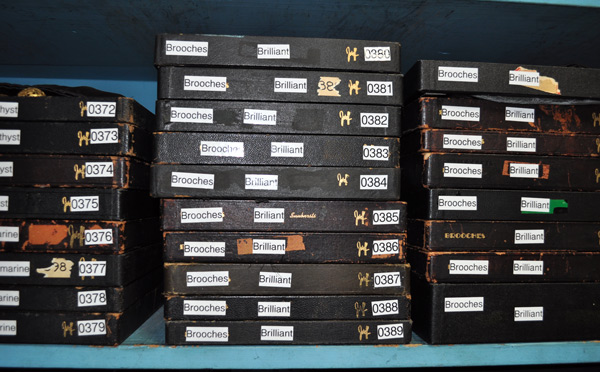
One studio wall is lined with trays of Joseff jewelry. The pieces are organized by type and by color. This is funny because the movie stills the Joseffs have to identify pieces are in black-and-white.
“We also have a whole building that’s nothing but storage, and it’s box after box after box of papers, newspaper articles, and magazine articles,” Tina Joseff says. “She saved things like airline tickets and matchbooks from hotels, so I know where she’s been and I know how long she stayed. She kept just all sorts of odd, little things that you wouldn’t even know people collect, but she did. She just saved everything. She really left behind quite an archive.”
“In the ’30s and ’40s, it made you feel a little sassy when you wore something you saw in a movie.”Tina Joseff’s daughter, Michele, is currently working on photographing and archiving the whole collection to post it on the company web site, in hopes of making the studio rental process smoother, and breathing new life into the once-bustling movie rental business.
That said, the Joseffs are particular about who they rent their jewelry to. Not just any Joe can walk in off the street and walk away with a historic piece of jewelry.
“There are people that we work with all the time that we trust and that I know take very good care,” Tina says. “If it’s somebody new that I’ve never met, I’m a little more leery about renting to them. When I see how they treat the jewelry after they bring it back—if it’s all in the trays, it’s laid out nice, and they’ve got the covers on it—I know they respect the jewelry for what it is.”
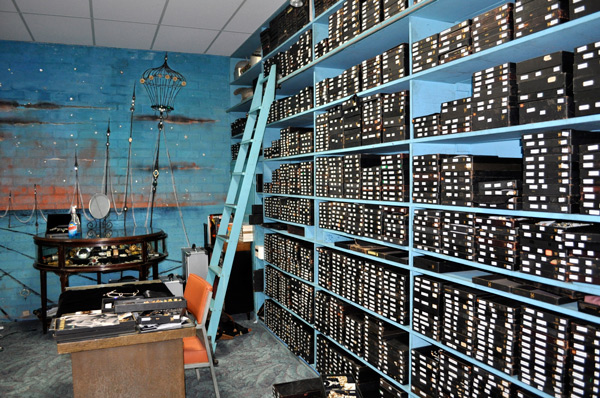
This turquoise vault of Hollywood treasures has been meticulously preserved through half a century.
They have traveled the world appearing in museum shows in Barcelona, Paris, Milan, and London, as well as the L.A. County Museum of Art, and the Academy of Motion Pictures, but they will never see the bright studio lights again.
“There’s only one of the Clark Gable cigar case from ‘Gone With the Wind,’” Tina explains as we wrap up the tour. “That piece will never leave our studio except maybe as a museum exhibit. Its rental days are over.”
Which makes this visit to the hidden Joseff of Hollywood studio all the more magical. Rarely would someone get the chance to see—much less touch or try on—these valuable Hollywood treasures, without a personal invitation from Tina Joseff herself.

Joan poses wearing her company’s crown jewels on her voluminous
Jewellery has been around since the beginning of time. Since the first married woman put on her first stone ring, jewelry has been made from virtually all the earth's elements. From rock, sand, gold, silver, steel, wood and every other imaginable element. There's history in collectible and keepsake jewellery like this, but does modern costume jewellery have a history?
Yes. And a rich one, too.
The history of costume jewellery dates back only about 300 years. During the early 18th century, modest-living women started acquiring a strong desire for the same jewellery worn by upper-class women.
No one knows for sure what spurred this desire, but the desire was definitely there. Some speculate that it had to do with the growing population: As the population grew, rural families and urban families started moving closer together; in turn, this put modest housewives in closer proximity to wealthier, more fashionable ladies living in the city.
Although the origin of costume jewellery dates back 300 years, it wasn't until the mid-20 twentieth century that the new jewellery form really took shape.
The Art Deco Period
If you want a good picture of what costume jewellery looked like in the Art Deco Period, think of middle-class women who frequented speakeasies during the Prohibition. Gold-like pendants hanging from earlobes, cocktail rings on delicate hands signaling the barkeep, loose bracelets, and accessory items like cigarette holders.
This period started in 1920 and ran into the early 1930s. The loose, free-hanging jewellery and fancy cigarette cases of the Art Deco Period eventually died off a decade after the Prohibition ended. Quite possibly, the rebellious characteristics of this fashion died shortly after the alcohol rebellion itself.
Retro Period
As the war waged on in Europe, many European jewellery companies moved their business to America where the economy was quickly recovering from the Great Depression. Consequently, this had an impact on the appearance of products. The design of costume items in the Art Modern Period (1935-1950) had a Western twist. Like the American capitalist train of thought, less was not more – more was more. The same applied to costume items of this period.
Now, instead of speakeasies, think of big shows that women attended while their husbands were off fighting the war. Think of them in theater seats, compensating their loneliness with big, vibrant jewels. These jewels, although plastic-based, were worn by middle-class and upper-class women alike. With the war being on, the jewellery they wore had an added purpose: to make worrisome days a little more cheerful.
Art Modern Period
When the Art Modern period of costume items coincided with the Retro Period in the late 40's, jewellery grew even more in size. However, items became more understated and simple. Perhaps women didn't need the flash now that their husbands were home and the war was over. Perhaps, even though they still loved jewelry, they didn't feel the need to make it sparkle and draw attention. The fighting men deserved attention now.
But that is speculation.
Speculation aside, the Art Modern Period did include charm bracelets and keepsake-like items, as well as happy-go-lucky pins inspired by the optimism of the 50's.
Today, costume pieces are more popular than ever and easy to get. They're affordable, too!
Jewellery has been around since the beginning of time. Since the first married woman put on her first stone ring, jewelry has been made from virtually all the earth's elements. From rock, sand, gold, silver, steel, wood and every other imaginable element. There's history in collectible and keepsake jewellery like this, but does modern costume jewellery have a history?
Yes. And a rich one, too.
The history of costume jewellery dates back only about 300 years. During the early 18th century, modest-living women started acquiring a strong desire for the same jewellery worn by upper-class women.
No one knows for sure what spurred this desire, but the desire was definitely there. Some speculate that it had to do with the growing population: As the population grew, rural families and urban families started moving closer together; in turn, this put modest housewives in closer proximity to wealthier, more fashionable ladies living in the city.
Although the origin of costume jewellery dates back 300 years, it wasn't until the mid-20 twentieth century that the new jewellery form really took shape.
The Art Deco Period
If you want a good picture of what costume jewellery looked like in the Art Deco Period, think of middle-class women who frequented speakeasies during the Prohibition. Gold-like pendants hanging from earlobes, cocktail rings on delicate hands signaling the barkeep, loose bracelets, and accessory items like cigarette holders.
This period started in 1920 and ran into the early 1930s. The loose, free-hanging jewellery and fancy cigarette cases of the Art Deco Period eventually died off a decade after the Prohibition ended. Quite possibly, the rebellious characteristics of this fashion died shortly after the alcohol rebellion itself.
Retro Period
As the war waged on in Europe, many European jewellery companies moved their business to America where the economy was quickly recovering from the Great Depression. Consequently, this had an impact on the appearance of products. The design of costume items in the Art Modern Period (1935-1950) had a Western twist. Like the American capitalist train of thought, less was not more – more was more. The same applied to costume items of this period.
Now, instead of speakeasies, think of big shows that women attended while their husbands were off fighting the war. Think of them in theater seats, compensating their loneliness with big, vibrant jewels. These jewels, although plastic-based, were worn by middle-class and upper-class women alike. With the war being on, the jewellery they wore had an added purpose: to make worrisome days a little more cheerful.
Art Modern Period
When the Art Modern period of costume items coincided with the Retro Period in the late 40's, jewellery grew even more in size. However, items became more understated and simple. Perhaps women didn't need the flash now that their husbands were home and the war was over. Perhaps, even though they still loved jewelry, they didn't feel the need to make it sparkle and draw attention. The fighting men deserved attention now.
But that is speculation.
Speculation aside, the Art Modern Period did include charm bracelets and keepsake-like items, as well as happy-go-lucky pins inspired by the optimism of the 50's.
Today, costume pieces are more popular than ever and easy to get. They're affordable, too!

No comments:
Post a Comment